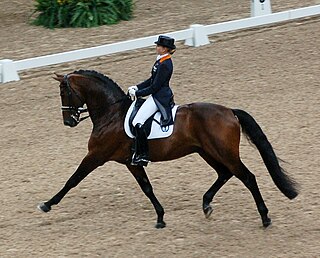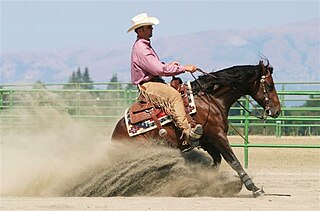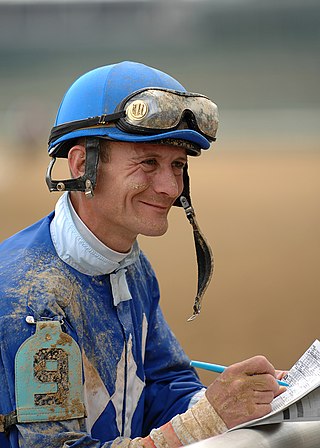
Dressage is a form of horse riding performed in exhibition and competition, as well as an art sometimes pursued solely for the sake of mastery. As an equestrian sport defined by the International Equestrian Federation, dressage is described as "the highest expression of horse training" where "horse and rider are expected to perform from memory a series of predetermined movements".

Equestrianism, commonly known as horse riding or horseback riding, includes the disciplines of riding, driving, and vaulting. This broad description includes the use of horses for practical working purposes, transportation, recreational activities, artistic or cultural exercises, and competitive sport.

The hand is a non-SI unit of measurement of length standardized to 4 in (101.6 mm). It is used to measure the height of horses in many English-speaking countries, including Australia, Canada, Ireland, the United Kingdom, and the United States. It was originally based on the breadth of a human hand. The adoption of the international inch in 1959 allowed for a standardized imperial form and a metric conversion. It may be abbreviated to "h" or "hh". Although measurements between whole hands are usually expressed in what appears to be decimal format, the subdivision of the hand is not decimal but is in base 4, so subdivisions after the radix point are in quarters of a hand, which are inches. Thus, 62 inches is fifteen and a half hands, or 15.2 hh.

The Hanoverian is a Warmblood horse breed originating in Germany, which is often seen in the Olympic Games and other competitive English riding styles, and has won gold medals in all three equestrian Olympic competitions. It is one of the oldest, most numerous, and most successful of the Warmblood breeds. Originally a cavalry horse, infusions of more Thoroughbred blood lightened it to make it more agile and useful for competition. The Hanoverian is known for a good temperament, athleticism, beauty, and grace.

A horse show is a judged exhibition of horses and ponies. Many different horse breeds and equestrian disciplines hold competitions worldwide, from local to the international levels. Most horse shows run from one to three days, sometimes longer for major, all-breed events or national and international championships in a given discipline or breed. Most shows consist of a series of different performances, called classes, wherein a group of horses with similar training or characteristics compete against one another for awards and, often, prize money.

Reining is a western riding competition for horses where the riders guide the horses through a precise pattern of circles, spins, and stops. All work is done at the lope, or the gallop. Originating from working cattle, reining requires the horse to be responsive and in tune with its rider, whose aids should not be easily seen, and judges the horse on its ability to perform a set pattern of movements. The horse should be willingly guided or controlled with little or no apparent resistance and dictated to completely. A horse that pins his ears, conveys a threat to his rider, refuses to go forward, runs sideways, bounces his rear, wrings his tail in irritation, or displays an overall poor attitude is not being guided willingly, and is judged accordingly.If a horse jogs or breaks gait it is a 0.

Endurance riding is an equestrian sport based on controlled long-distance races. It is one of the international competitions recognized by the FEI. There are endurance rides worldwide. Endurance rides can be any distance, though they are rarely over 160 km for a one-day competition.

The United States Equestrian Federation is the national governing body for most equestrian sports in the United States. It also recruits, trains, and governs American teams in international equestrian competition at the Olympics and other competitions governed by the International Federation for Equestrian Sports (FEI).
Debbie McDonald is an American dressage rider who has competed in the Olympics and many international competitions. She now lives in Hailey, Idaho, with her husband Bob, a hunter/jumper and trainer. Debbie trains and teaches riders on Peggy and E. Parry Thomas's River Grove Farm in Sun Valley, Idaho.

Equine influenza is the disease caused by strains of influenza A that are enzootic in horse species. Equine influenza occurs globally, previously caused by two main strains of virus: equine-1 (H7N7) and equine-2 (H3N8). The World Organisation for Animal Health now considers H7N7 strains likely to be extinct since these strains have not been isolated for over 20 years. Predominant international circulating H3N8 strains are Florida sublineage of the American lineage; clade 1 predominates in the Americas and clade 2 in Europe.. The disease has a nearly 100% infection rate in an unvaccinated horse population with no prior exposure to the virus.

An equestrian helmet is a form of protective headgear worn when riding horses. This type of helmet is specially designed to protect the rider's head in the event of falls from a horse, especially from striking a hard object while falling or being accidentally struck in the head by a horse's hoof.
Horse slaughter is the practice of slaughtering horses to produce meat for consumption. Humans have long consumed horse meat; the oldest known cave art, the 30,000-year-old paintings in France's Chauvet Cave, depict horses with other wild animals hunted by humans. Equine domestication is believed to have begun to raise horses for human consumption. The practice has become controversial in some parts of the world due to several concerns: whether horses are managed humanely in industrial slaughter; whether horses not raised for consumption yield safe meat, and whether it is appropriate to consume what some view as a companion animal.

A travel document is an identity document issued by a government or international entity pursuant to international agreements to enable individuals to clear border control measures. Travel documents usually assure other governments that the bearer may return to the issuing country, and are often issued in booklet form to allow other governments to place visas as well as entry and exit stamps into them.
Equestrian Canada, formerly known as Equine Canada and commonly known by its acronym, EC, is Canada’s comprehensive national governing body for equestrian sport. It is the executive branch of Canada's Olympic and Paralympic equestrian teams; the national association and registry of Canadian equestrian athletes; the national regulatory body for equestrian coaches, competition organizers, and judges; and the national federation of Canadian horse breeders and Canadian breed registries.
Rick Rockefeller-Silvia is an equestrian athlete, equine breeder and former model.

This is a basic glossary of equestrian terms that includes both technical terminology and jargon developed over the centuries for horses and other equidae, as well as various horse-related concepts. Where noted, some terms are used only in American English (US), only in British English (UK), or are regional to a particular part of the world, such as Australia (AU).

Sheila Varian was an American breeder of Arabian horses who lived and worked at the Varian Arabians Ranch near Arroyo Grande, California. She grew up with a strong interest in horses, and was mentored in horsemanship by Mary "Sid" Spencer, a local rancher and Morgan horse breeder who also introduced Varian to the vaquero or "Californio" tradition of western riding. She started her horse ranch, Varian Arabians, in 1954 with the assistance of her parents. Raising and training horses was her full-time occupation beginning in 1963. She used vaquero-influenced methods of training horses, although she adapted her technique over the years to fit the character of the Arabian horse, which she viewed as a horse breed requiring a smart yet gentle approach.

Elisabeth Halliday is an American equestrian, race-car driver and commentator. She was born in San Diego, California, and currently lives in Lexington, Kentucky. Before becoming a full-time equestrian, Halliday was the most successful female driver in the American Le Mans Series with six victories. Halliday has stated that her ambition is to become the first woman to win the 24 Hours of Le Mans race and to earn a spot on the United States Equestrian Team.

Horse welfare or equine welfare helps describe the acceptable conditions of life and use for domesticated horses, in contrast to suffering produced by voluntary or involuntary actions of others, whether through physical abuse, mutilation, neglect, transport, vivisection or other forms of ill treatment. Debates about the welfare and abuse of horses are recent. In the nineteenth century, when the sight of a horse dying while working was commonplace, the first wave of awareness was born with the Society for the Prevention of Cruelty to Animals and the publication of the novel Black Beauty in England. France followed suit with the creation of the French League for the Protection of the Horse and the passage of the Grammont Law in 1850. Similar concerns over animal welfare developed in the United States. The debate intensified and extended throughout North America and Europe over the next century, particularly regarding the use of the horse during war, the use of horses as working animals on city streets, sports training, horse slaughter, and conditions of horse breeding and keeping. In the United States, the practice of soring resulted in the passage of the Horse Protection Act of 1970 and various organizations protested against abuses in horse racing and rodeo. In the early twenty-first century, these issues remained in the public eye and new controversies arose, especially about training methods such as Rollkur, problems in the field of endurance riding, stable confinement, and the presence of carriage horses in modern cities such as New York City.
Richard Rankin Fellers is an American former Olympic equestrian and horse trainer. In 2023 he pled guilty to sexually abusing one of his students when she was 17. According to the Washington County, Oregon district attorney, he will serve 30 months in state prison concurrently with a four year federal sentence.















